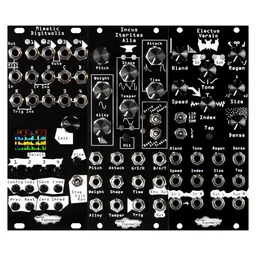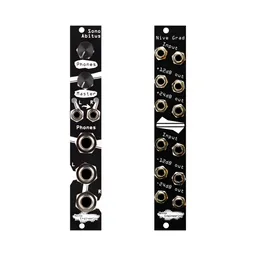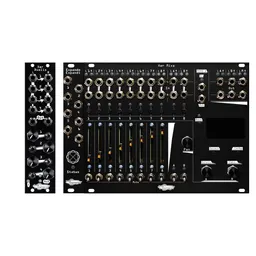Getting started: tuning revisited
If your goal is to play melodic music, keeping your system in tune is a big priority. Tuning can be challenging: if you’ve ever played a string instrument you’ll know that tuning before a session is a must, with some instruments being especially fickle and requiring lots of retuning and attention.
Modular synths also require some attention to stay in tune, and so today, we’ll revisit the topic of tuning your Eurorack system. We’ll chat about goals, best practices, and some common speedbumps you may encounter along the way.
What is your patching goal?
It may be tempting to try to tune all of your oscillators to the same pitch, then go from there. However, this can lead to a variety of hiccups. Oscillators aren’t perfect, especially analog ones – this is part of their charm, in fact; sequencers can be limited in their ranges, and a variety of patching techniques can introduce small variations in your pitch that will need to be accounted for. We’ll talk more about each of these.
The goal when tuning is to make your oscillators and sequencers (and any other pitch utilities) perform their best for the particular patch that you’re creating. Understanding how they’ll work together is a key point for making a patch work well.
For example, in a majority of my jams, I tend to split up my patches with multiple voices covering different ranges: one or two melodic voices in the bass range, one or two in the lead range, and a few different tuned percussion instruments. Starting out with bass voices in the bass range and lead voices in the lead range makes life much easier: if my basses are a few octaves lower than my leads, my patch is closer to the musical goal I want to achieve before I even start composing. This is particularly true when using techniques like analog FM which tend to be particularly sensitive to tracking differences.
As a counterexample, if my goal is to create a polyphonic patch with lots of interacting harmonies and chords, I may want to tune all my voices to the same note in the same octave instead.
Thinking about what you want a patch to do before you start a utilitarian task like tuning can make a big difference in how fast you get things to sound their best.
Voltage-range relationships
Another reason I like to decide what my voices will do before I start tuning is that often oscillators and sequencers will have different voltage ranges, meaning that we’re often limited to 4-5 octaves of range.
For example, one of my favorite sequencers has a -5V to +5V range, but my Loquelic Iteritas has a 0V to +8V pitch input. This means I can’t use more than five octaves of range with those two patched together (at least not without some pitch CV utilities), so planning on where I want the lowest note of my LI to be will save me a headache in the future.
This doesn’t serve as a real limitation for what I can do, since I almost never want a voice to span more than 3 octaves anyway (coming from classical music, this is a relatively standard range for an instrument, but of course taste is subjective). Still, making sure that I start at the correct pitch for my musical idea helps avoid any further issues.
Referencing the CV ranges of your oscillators and sequencers may seem like a mundane task, but I find it quite helpful in the long run.
Setting up for success
Before we get to the actual tuning part, there are a couple of prerequisites to make things easier.
First, let your system warm up for a few minutes (10 is usually more than enough). Some analog oscillators change frequency as they change temperature, so waiting for them to reach temperature stability helps keep tuning accurate.
Next, tune after you patch everything. This makes the biggest difference, and will help avoid surprises down the line. Of course, you may need to set things to roughly the correct frequencies as you go, but any module in the pitch CV chain can introduce tiny offsets that will throw off tuning if you try to tune before everything is hooked up.
I also like to tune to a C, generally one or two octaves above the lowest note on my sequencer. Many sequencers treat 0V/1V/2V/etc., as C, so this keeps note displays accurate and makes it easy for me to compose with a few octaves of range in my sequencer’s comfort zone. Always check your sequencer’s manual for these details!
Actually tuning
You’ve patched everything together, warmed up your system, and now we’re ready to tune! There are two strategies you can use to tune: by ear, or with a tuner. In general, I use both: I don’t have perfect pitch so I’ll tune one of my voices with a tuner like Soleo Vero, then tune the rest of my voices by ear to that voice.
To use a tuner, just patch your oscillator into its input and adjust the frequency control. Some tuners require you to select a goal note, and others just display what’s happening at the input. If your note is flat, turn the frequency up; if it’s sharp, turn the frequency down.

Tuning by ear takes a bit more practice, but I find that it’s a valuable skill to have and can be a bit more broadly applicable.
Play a note on one of your voices that’s already in tune, then adjust the frequency of the next voice to match. As you get the frequencies closer together, an audible wobbling effect called beating will happen, and the closer the voices are to being the same frequency, the slower the wobbling will be. Many oscillators have fine tuning parameters; start with the coarse tuning control, then once your frequencies are close together finish off with the fine tune control. With some practice you’ll be able to tune quickly and with excellent accuracy.
Here's an example of two saw waves being tuned together. Notice the beating effect slow down as they get closer in frequency.
What is C0?
A question we receive quite a bit, especially from users who want to integrate their setups with MIDI devices, is how to tune an oscillator to C0. This is a tough question, because there’s not really a defined Hertz value for C0 – DAWs even differ in their note numbering!
If you’re trying to make your modular system match a DAW synthesizer or another piece of hardware, I would recommend generating a reference pitch from a plugin synthesizer or other gear and tuning your Eurorack system to that. This tends to be the most straightforward approach to making things play nicely.
Tuning vs. tracking
One important distinction is the difference between tuning and tracking. Tuning is the act of setting an oscillator to a specific note. Tracking, however, is how your oscillator responds to incoming pitch CV. If you tune an oscillator to a C, then send it an exactly 2V signal, the oscillator should play a C two octaves higher. If you tuned it to a B, and sent it a 2V signal, it would then play a B two octaves higher.
You may see calibration instructions in your oscillator’s user manual, which will adjust the tracking of an oscillator. Oscillators are generally calibrated at the factory when they are built (unless you have a DIY!), so these are just here as a “just in case.” It is almost never necessary to recalibrate an oscillator, so don’t worry too much about tracking unless your oscillator is responding wildly inaccurately – for example, semitones out of tune across a span of an octave or two.






